Abstract
The vaginal microflora of 49 women in idiopathic preterm labor was compared with that of 38 term controls to determine whether the presence of bacterial vaginosis (BV) and/or specific microorganisms would influence the rate of preterm delivery. Demographic factors, pregnancy outcome, and reproductive history were also studied. BV, as defined by the presence of clue cells in a vaginal wet mount and characteristic microbial findings in a stained vaginal smear and vaginal culture, was more common in women with preterm labor and delivery than in controls (P < 0.01). The condition, diagnosed in 41% of women who had both preterm labor and delivery (n = 22) and in 11% each of women who had preterm labor but term delivery (n = 27) and controls, was associated with a 2.1-fold risk (95% confidence intervals, 1.2 to 3.7) for preterm birth prior to 37 weeks of gestation. BV was associated with low birth weight. Of 49 women with preterm labor, 67% (8 of 12) of women with BV were delivered of low-birth-weight neonates (< 2,500 g) compared with 22% (8 of 37) of women without the condition (P < 0.0005). The presence of hydrogen peroxide-producing facultative Lactobacillus spp. was strongly negatively associated with both preterm delivery and BV. BV-associated microorganisms, i.e., Mobiluncus, Prevotella, and Peptostreptococcus species, Porphyromonas asaccharolytica, Fusobacterium nucleatum, Mycoplasma hominis, and high numbers of Gardnerella vaginalis were significantly associated with preterm delivery; all species also strongly associated with BV (P = 0.0001 for each comparison). Mobiluncus curtisii and Fusobacterium nucleatum were recovered exclusively from women with preterm delivery. Our study clearly indicates that BV and its associated organisms are correlated with idiopathic premature delivery.
Full text
PDF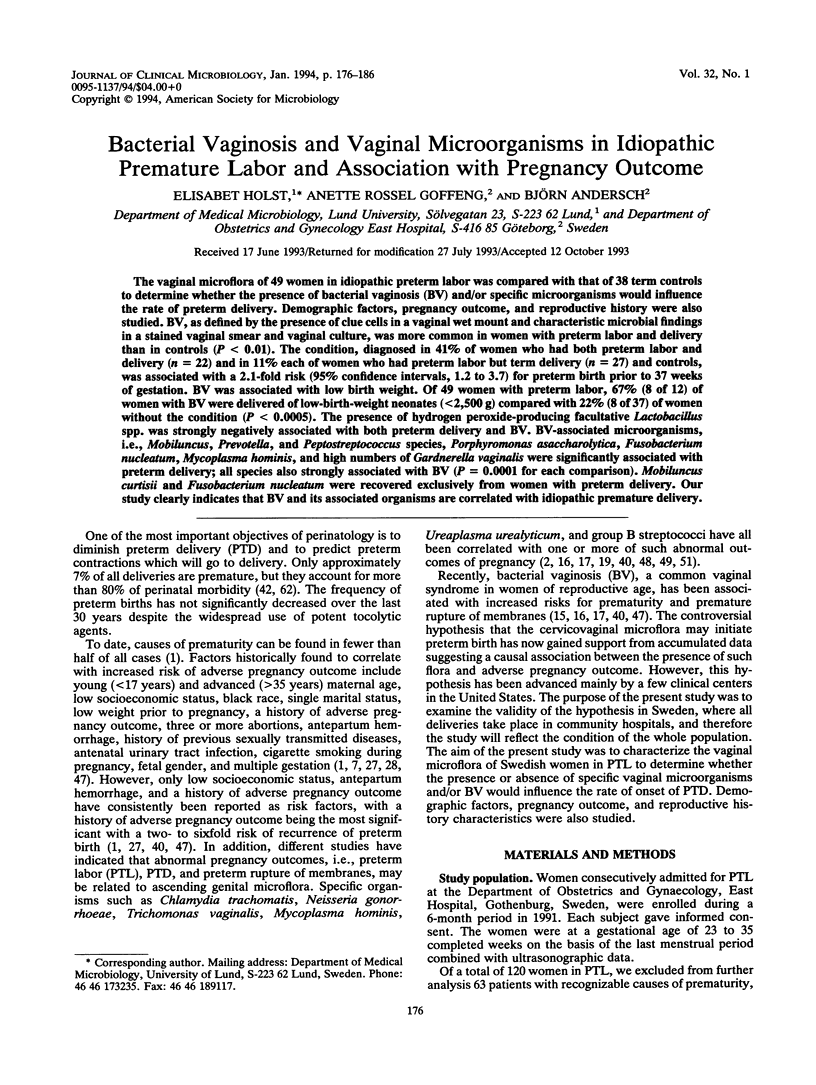
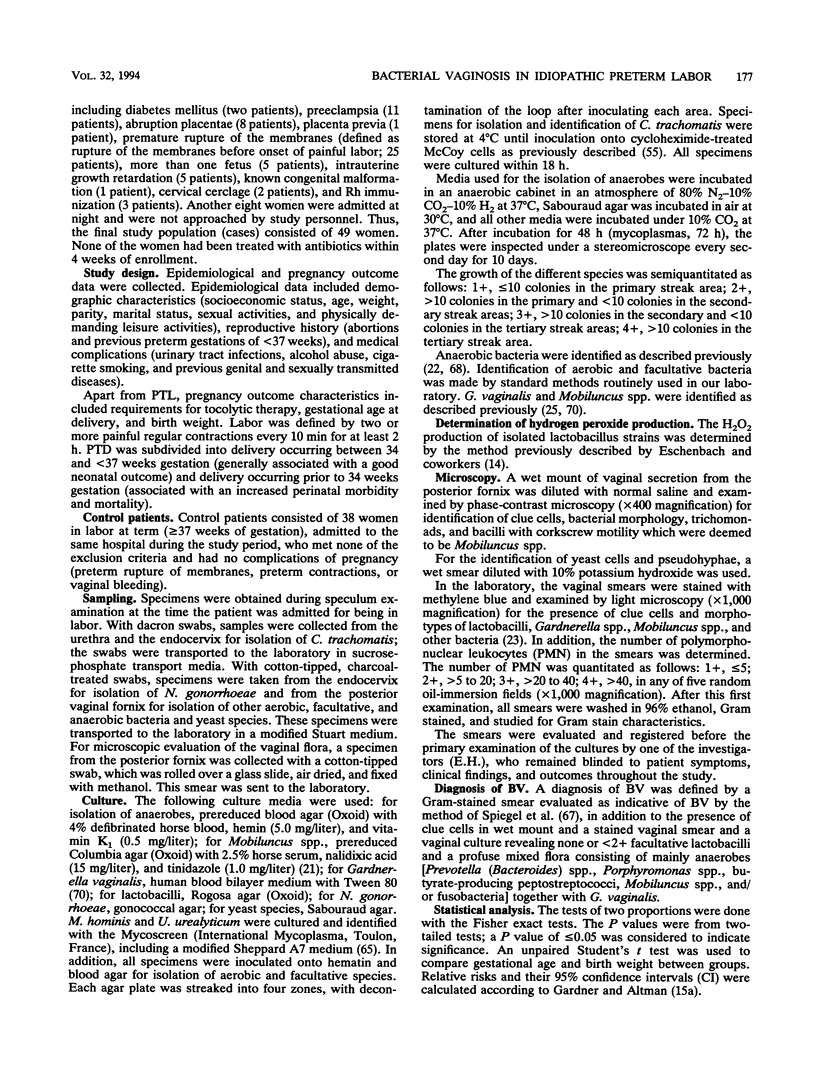
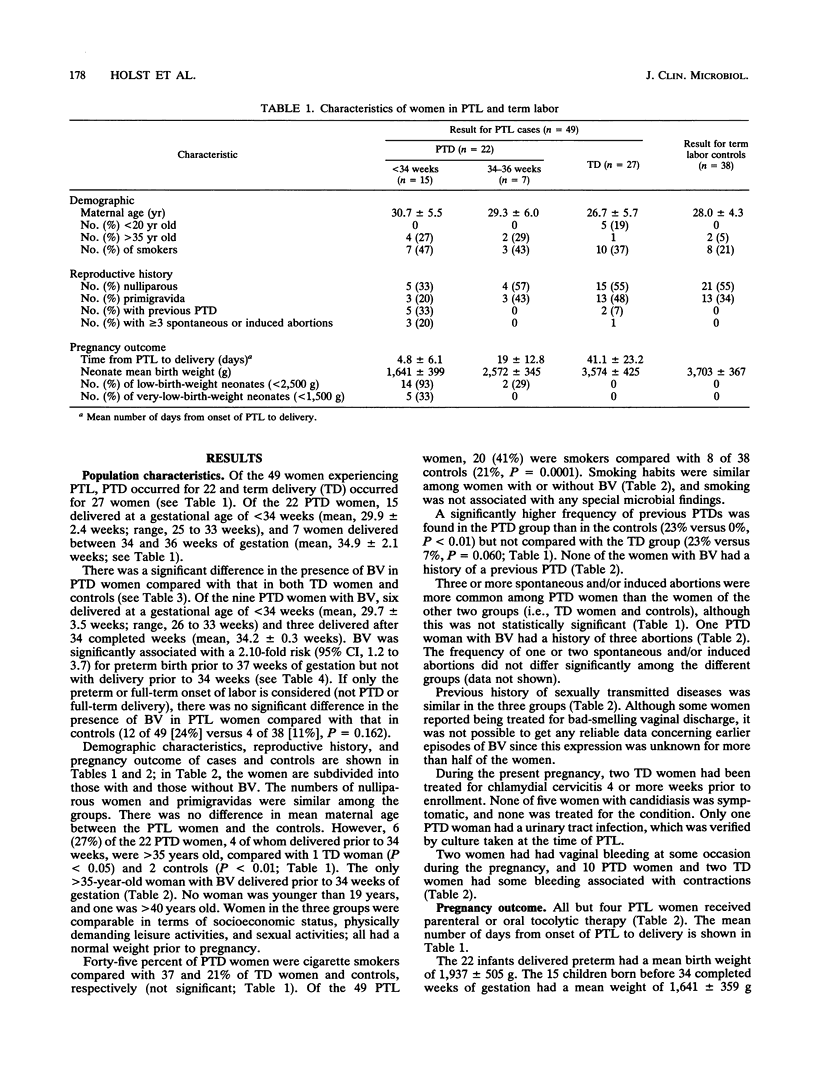
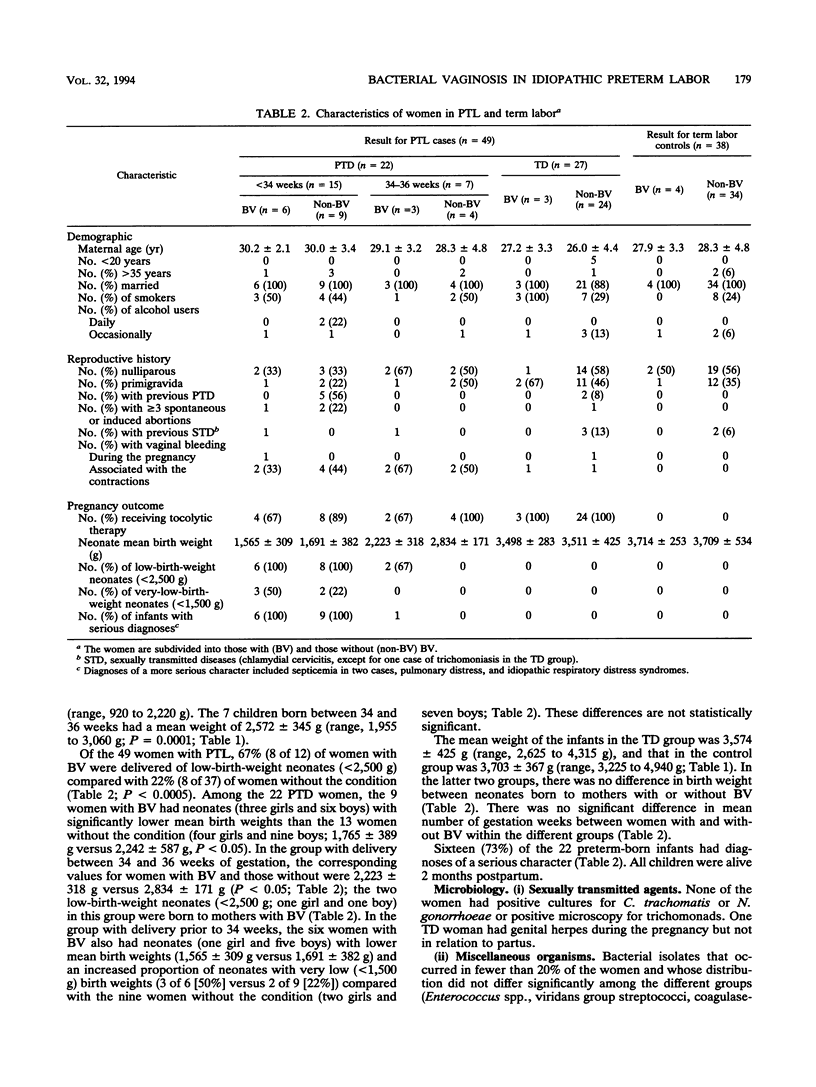
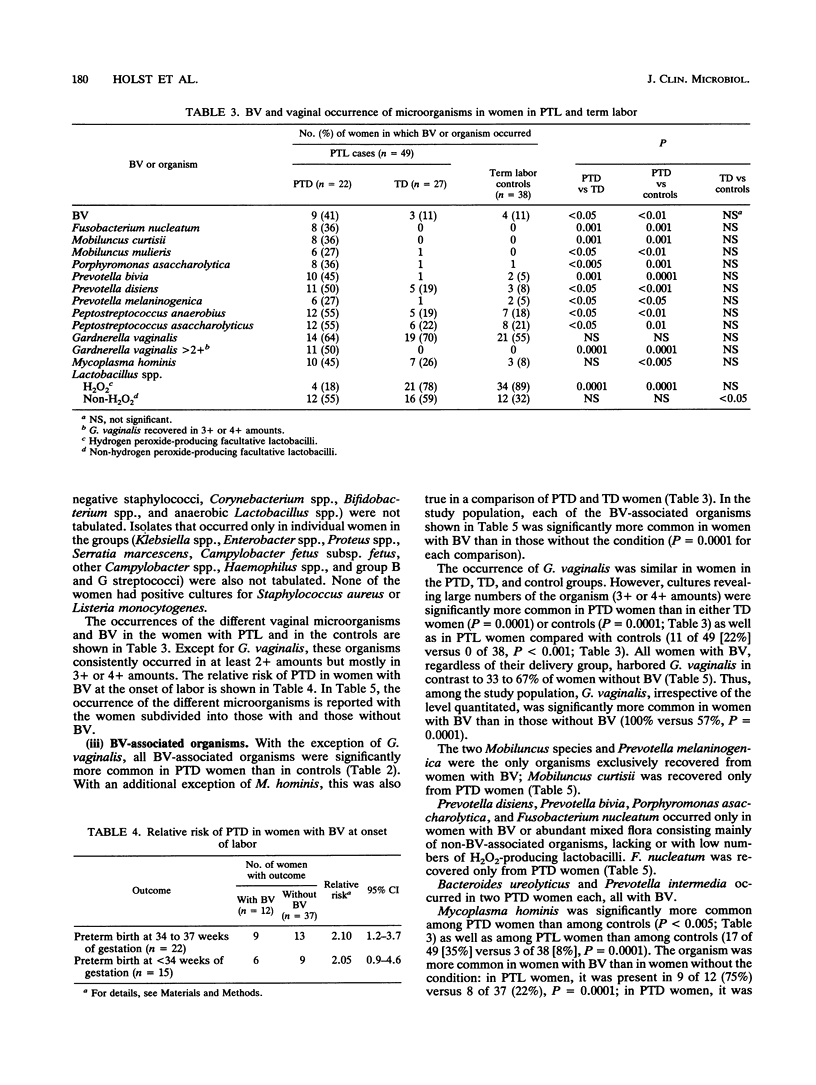
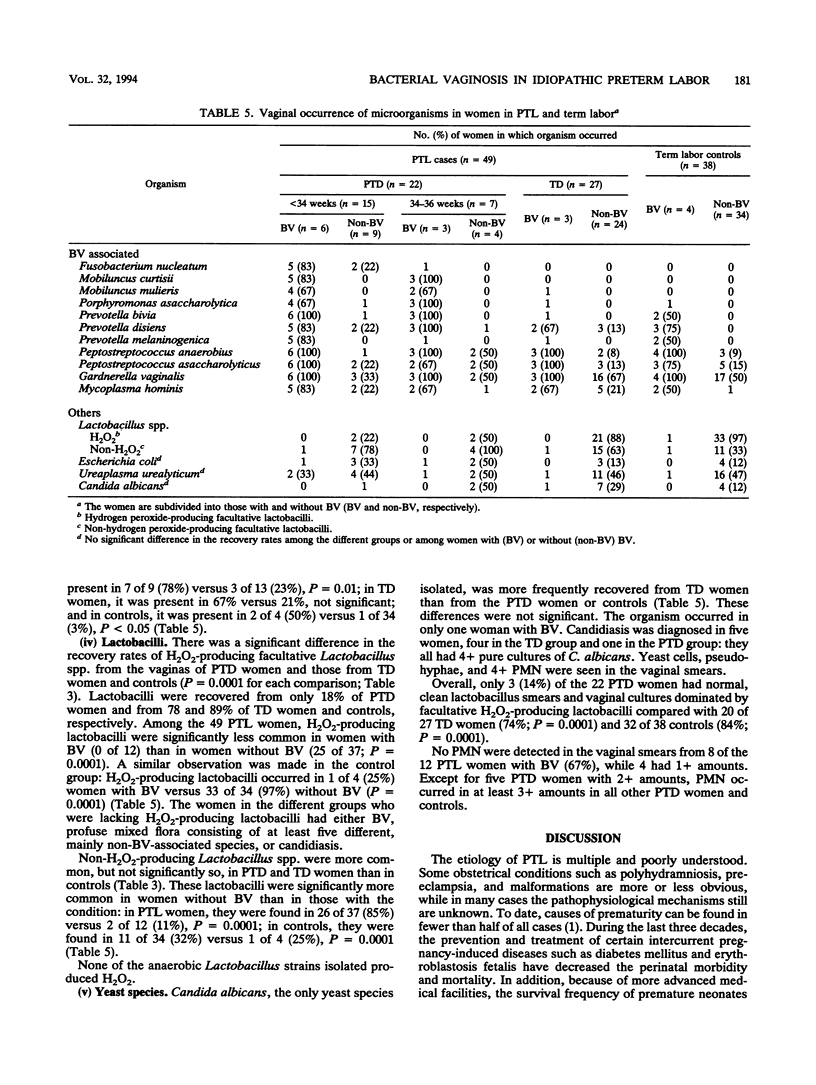
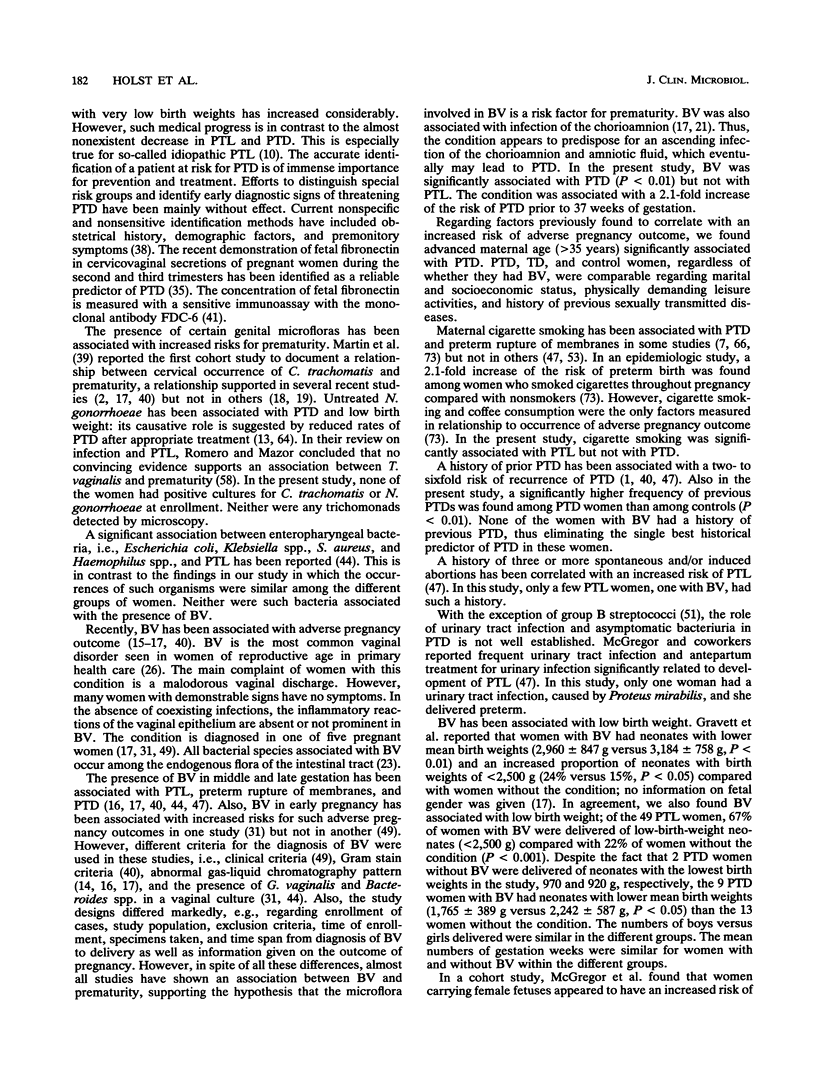
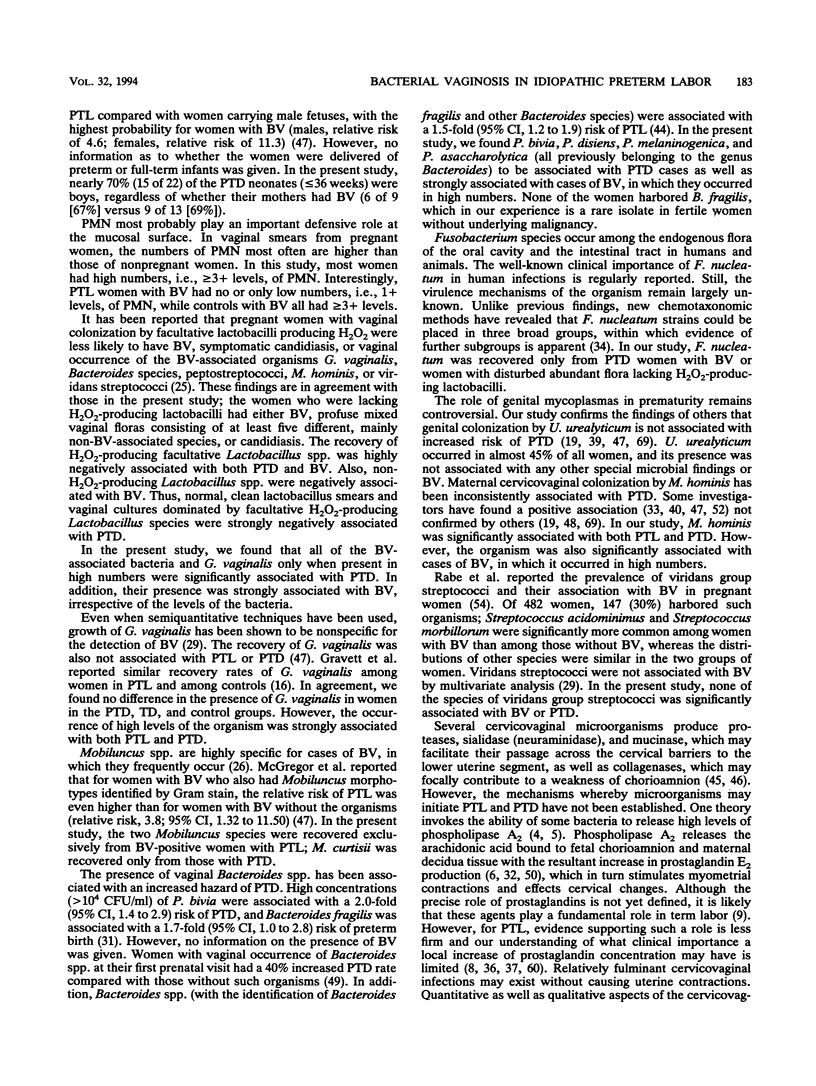
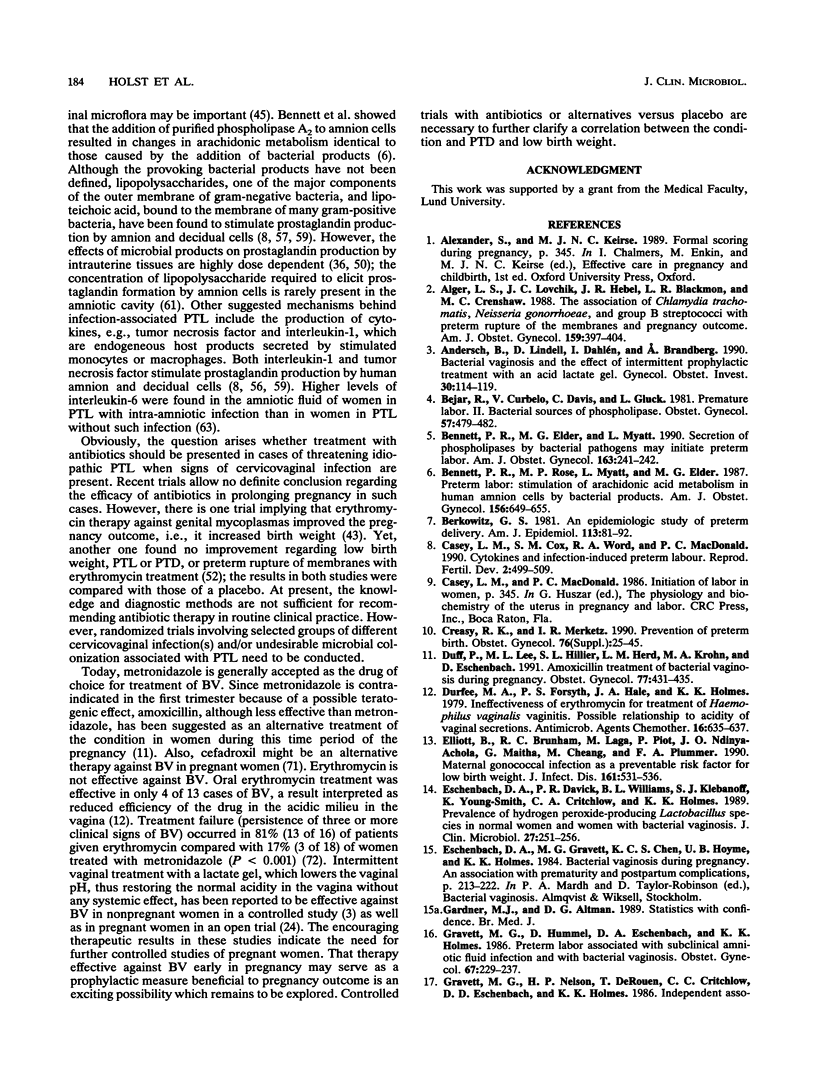
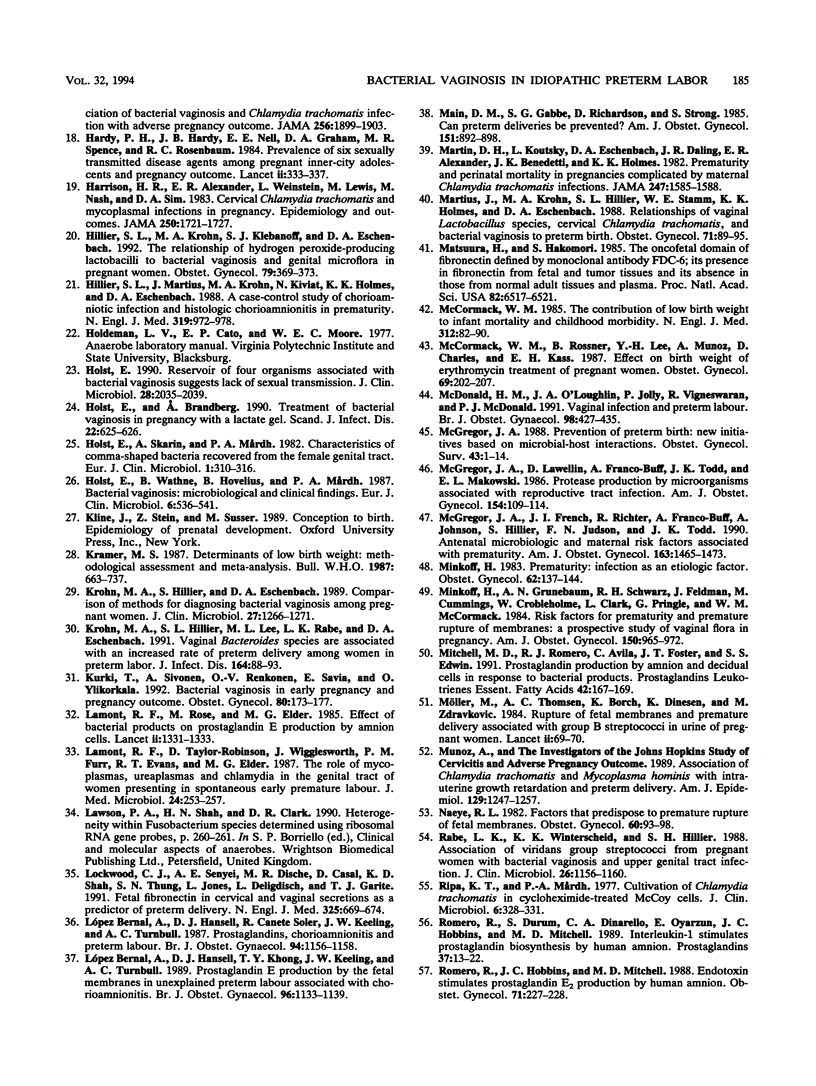
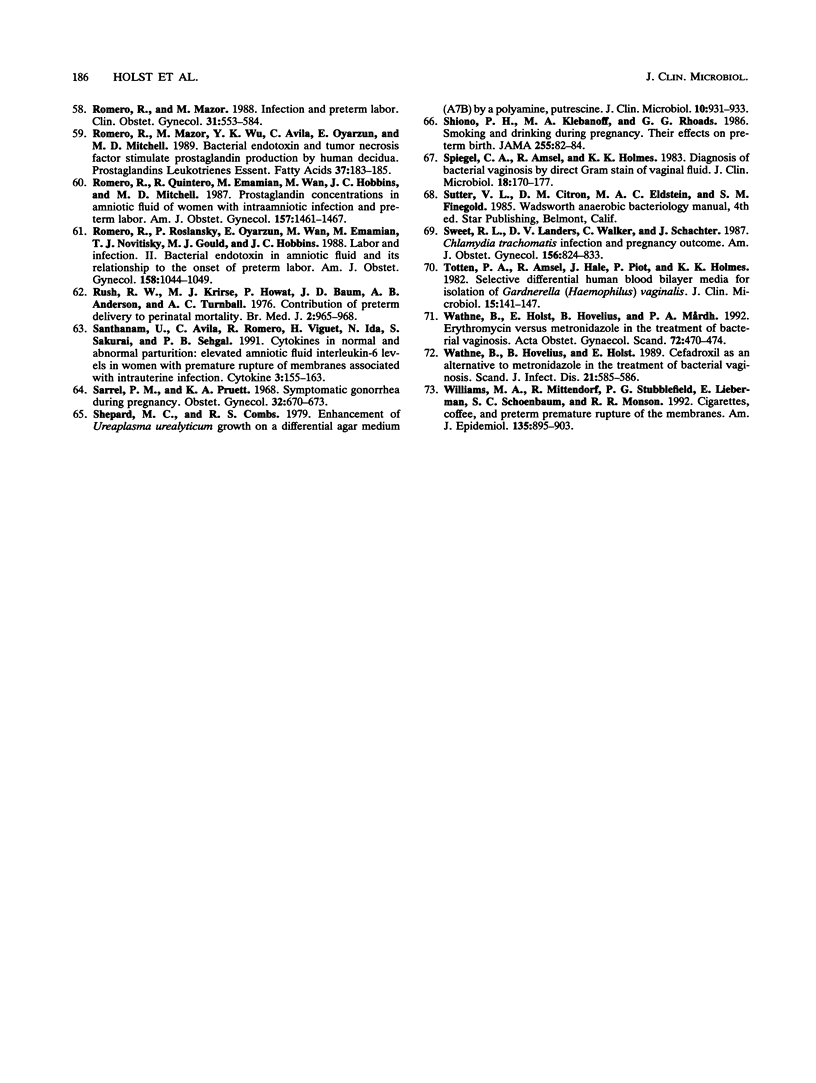
Selected References
These references are in PubMed. This may not be the complete list of references from this article.
- Alger L. S., Lovchik J. C., Hebel J. R., Blackmon L. R., Crenshaw M. C. The association of Chlamydia trachomatis, Neisseria gonorrhoeae, and group B streptococci with preterm rupture of the membranes and pregnancy outcome. Am J Obstet Gynecol. 1988 Aug;159(2):397–404. doi: 10.1016/s0002-9378(88)80093-0. [DOI] [PubMed] [Google Scholar]
- Andersch B., Lindell D., Dahlén I., Brandberg A. Bacterial vaginosis and the effect of intermittent prophylactic treatment with an acid lactate gel. Gynecol Obstet Invest. 1990;30(2):114–119. doi: 10.1159/000293230. [DOI] [PubMed] [Google Scholar]
- Bejar R., Curbelo V., Davis C., Gluck L. Premature labor. II. Bacterial sources of phospholipase. Obstet Gynecol. 1981 Apr;57(4):479–482. [PubMed] [Google Scholar]
- Bennett P. R., Elder M. G., Myatt L. Secretion of phospholipases by bacterial pathogens may initiate preterm labor. Am J Obstet Gynecol. 1990 Jul;163(1 Pt 1):241–242. doi: 10.1016/s0002-9378(11)90709-1. [DOI] [PubMed] [Google Scholar]
- Bennett P. R., Rose M. P., Myatt L., Elder M. G. Preterm labor: stimulation of arachidonic acid metabolism in human amnion cells by bacterial products. Am J Obstet Gynecol. 1987 Mar;156(3):649–655. doi: 10.1016/0002-9378(87)90070-6. [DOI] [PubMed] [Google Scholar]
- Berkowitz G. S. An epidemiologic study of preterm delivery. Am J Epidemiol. 1981 Jan;113(1):81–92. doi: 10.1093/oxfordjournals.aje.a113068. [DOI] [PubMed] [Google Scholar]
- Butterfield C. R., Shockley M., San Miguel G., Rosa C. Routine screening for hepatitis B in an obstetric population. Obstet Gynecol. 1990 Jul;76(1):25–27. [PubMed] [Google Scholar]
- Casey M. L., Cox S. M., Word R. A., MacDonald P. C. Cytokines and infection-induced preterm labour. Reprod Fertil Dev. 1990;2(5):499–509. doi: 10.1071/rd9900499. [DOI] [PubMed] [Google Scholar]
- Duff P., Lee M. L., Hillier S. L., Herd L. M., Krohn M. A., Eschenbach D. A. Amoxicillin treatment of bacterial vaginosis during pregnancy. Obstet Gynecol. 1991 Mar;77(3):431–435. [PubMed] [Google Scholar]
- Durfee M. A., Forsyth P. S., Hale J. A., Holmes K. K. Ineffectiveness of erythromycin for treatment of Haemophilus vaginalis-associated vaginitis: possible relationship to acidity of vaginal secretions. Antimicrob Agents Chemother. 1979 Nov;16(5):635–637. doi: 10.1128/aac.16.5.635. [DOI] [PMC free article] [PubMed] [Google Scholar]
- Elliott B., Brunham R. C., Laga M., Piot P., Ndinya-Achola J. O., Maitha G., Cheang M., Plummer F. A. Maternal gonococcal infection as a preventable risk factor for low birth weight. J Infect Dis. 1990 Mar;161(3):531–536. doi: 10.1093/infdis/161.3.531. [DOI] [PubMed] [Google Scholar]
- Eschenbach D. A., Davick P. R., Williams B. L., Klebanoff S. J., Young-Smith K., Critchlow C. M., Holmes K. K. Prevalence of hydrogen peroxide-producing Lactobacillus species in normal women and women with bacterial vaginosis. J Clin Microbiol. 1989 Feb;27(2):251–256. doi: 10.1128/jcm.27.2.251-256.1989. [DOI] [PMC free article] [PubMed] [Google Scholar]
- Eschenbach D. A., Gravett M. G., Chen K. C., Hoyme U. B., Holmes K. K. Bacterial vaginosis during pregnancy. An association with prematurity and postpartum complications. Scand J Urol Nephrol Suppl. 1984;86:213–222. [PubMed] [Google Scholar]
- Gravett M. G., Hummel D., Eschenbach D. A., Holmes K. K. Preterm labor associated with subclinical amniotic fluid infection and with bacterial vaginosis. Obstet Gynecol. 1986 Feb;67(2):229–237. doi: 10.1097/00006250-198602000-00013. [DOI] [PubMed] [Google Scholar]
- Gravett M. G., Nelson H. P., DeRouen T., Critchlow C., Eschenbach D. A., Holmes K. K. Independent associations of bacterial vaginosis and Chlamydia trachomatis infection with adverse pregnancy outcome. JAMA. 1986 Oct 10;256(14):1899–1903. [PubMed] [Google Scholar]
- Hardy P. H., Hardy J. B., Nell E. E., Graham D. A., Spence M. R., Rosenbaum R. C. Prevalence of six sexually transmitted disease agents among pregnant inner-city adolescents and pregnancy outcome. Lancet. 1984 Aug 11;2(8398):333–337. doi: 10.1016/s0140-6736(84)92698-9. [DOI] [PubMed] [Google Scholar]
- Harrison H. R., Alexander E. R., Weinstein L., Lewis M., Nash M., Sim D. A. Cervical Chlamydia trachomatis and mycoplasmal infections in pregnancy. Epidemiology and outcomes. JAMA. 1983 Oct 7;250(13):1721–1727. [PubMed] [Google Scholar]
- Hillier S. L., Krohn M. A., Klebanoff S. J., Eschenbach D. A. The relationship of hydrogen peroxide-producing lactobacilli to bacterial vaginosis and genital microflora in pregnant women. Obstet Gynecol. 1992 Mar;79(3):369–373. doi: 10.1097/00006250-199203000-00008. [DOI] [PubMed] [Google Scholar]
- Hillier S. L., Martius J., Krohn M., Kiviat N., Holmes K. K., Eschenbach D. A. A case-control study of chorioamnionic infection and histologic chorioamnionitis in prematurity. N Engl J Med. 1988 Oct 13;319(15):972–978. doi: 10.1056/NEJM198810133191503. [DOI] [PubMed] [Google Scholar]
- Holst E., Brandberg A. Treatment of bacterial vaginosis in pregnancy with a lactate gel. Scand J Infect Dis. 1990;22(5):625–626. doi: 10.3109/00365549009027109. [DOI] [PubMed] [Google Scholar]
- Holst E. Reservoir of four organisms associated with bacterial vaginosis suggests lack of sexual transmission. J Clin Microbiol. 1990 Sep;28(9):2035–2039. doi: 10.1128/jcm.28.9.2035-2039.1990. [DOI] [PMC free article] [PubMed] [Google Scholar]
- Holst E., Skarin A., Mårdh P. A. Characteristics of anaerobic comma-shaped bacteria recovered from the female genital tract. Eur J Clin Microbiol. 1982 Oct;1(5):310–316. doi: 10.1007/BF02019978. [DOI] [PubMed] [Google Scholar]
- Holst E., Wathne B., Hovelius B., Mårdh P. A. Bacterial vaginosis: microbiological and clinical findings. Eur J Clin Microbiol. 1987 Oct;6(5):536–541. doi: 10.1007/BF02014242. [DOI] [PubMed] [Google Scholar]
- Kramer M. S. Determinants of low birth weight: methodological assessment and meta-analysis. Bull World Health Organ. 1987;65(5):663–737. [PMC free article] [PubMed] [Google Scholar]
- Krohn M. A., Hillier S. L., Eschenbach D. A. Comparison of methods for diagnosing bacterial vaginosis among pregnant women. J Clin Microbiol. 1989 Jun;27(6):1266–1271. doi: 10.1128/jcm.27.6.1266-1271.1989. [DOI] [PMC free article] [PubMed] [Google Scholar]
- Krohn M. A., Hillier S. L., Lee M. L., Rabe L. K., Eschenbach D. A. Vaginal Bacteroides species are associated with an increased rate of preterm delivery among women in preterm labor. J Infect Dis. 1991 Jul;164(1):88–93. doi: 10.1093/infdis/164.1.88. [DOI] [PubMed] [Google Scholar]
- Kurki T., Sivonen A., Renkonen O. V., Savia E., Ylikorkala O. Bacterial vaginosis in early pregnancy and pregnancy outcome. Obstet Gynecol. 1992 Aug;80(2):173–177. [PubMed] [Google Scholar]
- Lamont R. F., Rose M., Elder M. G. Effect of bacterial products on prostaglandin E production by amnion cells. Lancet. 1985 Dec 14;2(8468):1331–1333. doi: 10.1016/s0140-6736(85)92628-5. [DOI] [PubMed] [Google Scholar]
- Lamont R. F., Taylor-Robinson D., Wigglesworth J. S., Furr P. M., Evans R. T., Elder M. G. The role of mycoplasmas, ureaplasmas and chlamydiae in the genital tract of women presenting in spontaneous early preterm labour. J Med Microbiol. 1987 Nov;24(3):253–257. doi: 10.1099/00222615-24-3-253. [DOI] [PubMed] [Google Scholar]
- Lockwood C. J., Senyei A. E., Dische M. R., Casal D., Shah K. D., Thung S. N., Jones L., Deligdisch L., Garite T. J. Fetal fibronectin in cervical and vaginal secretions as a predictor of preterm delivery. N Engl J Med. 1991 Sep 5;325(10):669–674. doi: 10.1056/NEJM199109053251001. [DOI] [PubMed] [Google Scholar]
- López Bernal A., Hansell D. J., Cañete Soler R., Keeling J. W., Turnbull A. C. Prostaglandins, chorioamnionitis and preterm labour. Br J Obstet Gynaecol. 1987 Dec;94(12):1156–1158. doi: 10.1111/j.1471-0528.1987.tb02315.x. [DOI] [PubMed] [Google Scholar]
- López Bernal A., Hansell D. J., Khong T. Y., Keeling J. W., Turnbull A. C. Prostaglandin E production by the fetal membranes in unexplained preterm labour and preterm labour associated with chorioamnionitis. Br J Obstet Gynaecol. 1989 Oct;96(10):1133–1139. doi: 10.1111/j.1471-0528.1989.tb03187.x. [DOI] [PubMed] [Google Scholar]
- Main D. M., Gabbe S. G., Richardson D., Strong S. Can preterm deliveries be prevented? Am J Obstet Gynecol. 1985 Apr 1;151(7):892–898. doi: 10.1016/0002-9378(85)90667-2. [DOI] [PubMed] [Google Scholar]
- Martin D. H., Koutsky L., Eschenbach D. A., Daling J. R., Alexander E. R., Benedetti J. K., Holmes K. K. Prematurity and perinatal mortality in pregnancies complicated by maternal Chlamydia trachomatis infections. JAMA. 1982 Mar 19;247(11):1585–1588. [PubMed] [Google Scholar]
- Martius J., Krohn M. A., Hillier S. L., Stamm W. E., Holmes K. K., Eschenbach D. A. Relationships of vaginal Lactobacillus species, cervical Chlamydia trachomatis, and bacterial vaginosis to preterm birth. Obstet Gynecol. 1988 Jan;71(1):89–95. [PubMed] [Google Scholar]
- Matsuura H., Hakomori S. The oncofetal domain of fibronectin defined by monoclonal antibody FDC-6: its presence in fibronectins from fetal and tumor tissues and its absence in those from normal adult tissues and plasma. Proc Natl Acad Sci U S A. 1985 Oct;82(19):6517–6521. doi: 10.1073/pnas.82.19.6517. [DOI] [PMC free article] [PubMed] [Google Scholar]
- McCormack W. M., Rosner B., Lee Y. H., Munoz A., Charles D., Kass E. H. Effect on birth weight of erythromycin treatment of pregnant women. Obstet Gynecol. 1987 Feb;69(2):202–207. [PubMed] [Google Scholar]
- McCormick M. C. The contribution of low birth weight to infant mortality and childhood morbidity. N Engl J Med. 1985 Jan 10;312(2):82–90. doi: 10.1056/NEJM198501103120204. [DOI] [PubMed] [Google Scholar]
- McDonald H. M., O'Loughlin J. A., Jolley P., Vigneswaran R., McDonald P. J. Vaginal infection and preterm labour. Br J Obstet Gynaecol. 1991 May;98(5):427–435. doi: 10.1111/j.1471-0528.1991.tb10335.x. [DOI] [PubMed] [Google Scholar]
- McGregor J. A., French J. I., Richter R., Franco-Buff A., Johnson A., Hillier S., Judson F. N., Todd J. K. Antenatal microbiologic and maternal risk factors associated with prematurity. Am J Obstet Gynecol. 1990 Nov;163(5 Pt 1):1465–1473. doi: 10.1016/0002-9378(90)90607-9. [DOI] [PubMed] [Google Scholar]
- McGregor J. A., Lawellin D., Franco-Buff A., Todd J. K., Makowski E. L. Protease production by microorganisms associated with reproductive tract infection. Am J Obstet Gynecol. 1986 Jan;154(1):109–114. doi: 10.1016/0002-9378(86)90404-7. [DOI] [PubMed] [Google Scholar]
- McGregor J. A. Prevention of preterm birth: new initiatives based on microbial-host interactions. Obstet Gynecol Surv. 1988 Jan;43(1):1–14. [PubMed] [Google Scholar]
- Minkoff H., Grunebaum A. N., Schwarz R. H., Feldman J., Cummings M., Crombleholme W., Clark L., Pringle G., McCormack W. M. Risk factors for prematurity and premature rupture of membranes: a prospective study of the vaginal flora in pregnancy. Am J Obstet Gynecol. 1984 Dec 15;150(8):965–972. doi: 10.1016/0002-9378(84)90392-2. [DOI] [PubMed] [Google Scholar]
- Minkoff H. Prematurity: infection as an etiologic factor. Obstet Gynecol. 1983 Aug;62(2):137–144. [PubMed] [Google Scholar]
- Mitchell M. D., Romero R. J., Avila C., Foster J. T., Edwin S. S. Prostaglandin production by amnion and decidual cells in response to bacterial products. Prostaglandins Leukot Essent Fatty Acids. 1991 Mar;42(3):167–169. doi: 10.1016/0952-3278(91)90152-u. [DOI] [PubMed] [Google Scholar]
- Møller M., Thomsen A. C., Borch K., Dinesen K., Zdravkovic M. Rupture of fetal membranes and premature delivery associated with group B streptococci in urine of pregnant women. Lancet. 1984 Jul 14;2(8394):69–70. doi: 10.1016/s0140-6736(84)90242-3. [DOI] [PubMed] [Google Scholar]
- Naeye R. L. Factors that predispose to premature rupture of the fetal membranes. Obstet Gynecol. 1982 Jul;60(1):93–98. [PubMed] [Google Scholar]
- Rabe L. K., Winterscheid K. K., Hillier S. L. Association of viridans group streptococci from pregnant women with bacterial vaginosis and upper genital tract infection. J Clin Microbiol. 1988 Jun;26(6):1156–1160. doi: 10.1128/jcm.26.6.1156-1160.1988. [DOI] [PMC free article] [PubMed] [Google Scholar]
- Ripa K. T., Mårdh P. A. Cultivation of Chlamydia trachomatis in cycloheximide-treated mccoy cells. J Clin Microbiol. 1977 Oct;6(4):328–331. doi: 10.1128/jcm.6.4.328-331.1977. [DOI] [PMC free article] [PubMed] [Google Scholar]
- Romero R., Durum S., Dinarello C. A., Oyarzun E., Hobbins J. C., Mitchell M. D. Interleukin-1 stimulates prostaglandin biosynthesis by human amnion. Prostaglandins. 1989 Jan;37(1):13–22. doi: 10.1016/0090-6980(89)90028-2. [DOI] [PubMed] [Google Scholar]
- Romero R., Emamian M., Wan M., Quintero R., Hobbins J. C., Mitchell M. D. Prostaglandin concentrations in amniotic fluid of women with intra-amniotic infection and preterm labor. Am J Obstet Gynecol. 1987 Dec;157(6):1461–1467. doi: 10.1016/s0002-9378(87)80245-4. [DOI] [PubMed] [Google Scholar]
- Romero R., Hobbins J. C., Mitchell M. D. Endotoxin stimulates prostaglandin E2 production by human amnion. Obstet Gynecol. 1988 Feb;71(2):227–228. [PubMed] [Google Scholar]
- Romero R., Mazor M. Infection and preterm labor. Clin Obstet Gynecol. 1988 Sep;31(3):553–584. doi: 10.1097/00003081-198809000-00006. [DOI] [PubMed] [Google Scholar]
- Romero R., Mazor M., Wu Y. K., Avila C., Oyarzun E., Mitchell M. D. Bacterial endotoxin and tumor necrosis factor stimulate prostaglandin production by human decidua. Prostaglandins Leukot Essent Fatty Acids. 1989 Sep;37(3):183–186. doi: 10.1016/0952-3278(89)90083-5. [DOI] [PubMed] [Google Scholar]
- Romero R., Roslansky P., Oyarzun E., Wan M., Emamian M., Novitsky T. J., Gould M. J., Hobbins J. C. Labor and infection. II. Bacterial endotoxin in amniotic fluid and its relationship to the onset of preterm labor. Am J Obstet Gynecol. 1988 May;158(5):1044–1049. doi: 10.1016/0002-9378(88)90216-5. [DOI] [PubMed] [Google Scholar]
- Rush R. W., Keirse M. J., Howat P., Baum J. D., Anderson A. B., Turnbull A. C. Contribution of preterm delivery to perinatal mortality. Br Med J. 1976 Oct 23;2(6042):965–968. doi: 10.1136/bmj.2.6042.965. [DOI] [PMC free article] [PubMed] [Google Scholar]
- Santhanam U., Avila C., Romero R., Viguet H., Ida N., Sakurai S., Sehgal P. B. Cytokines in normal and abnormal parturition: elevated amniotic fluid interleukin-6 levels in women with premature rupture of membranes associated with intrauterine infection. Cytokine. 1991 Mar;3(2):155–163. doi: 10.1016/1043-4666(91)90037-e. [DOI] [PubMed] [Google Scholar]
- Sarrel P. M., Pruett K. A. Symptomatic gonorrhea during pregnancy. Obstet Gynecol. 1968 Nov;32(5):670–673. [PubMed] [Google Scholar]
- Shepard M. C., Combs R. S. Enhancement of Ureaplasma urealyticum growth on a differential agar medium (A7B) by a polyamine, putrescine. J Clin Microbiol. 1979 Dec;10(6):931–933. doi: 10.1128/jcm.10.6.931-933.1979. [DOI] [PMC free article] [PubMed] [Google Scholar]
- Shiono P. H., Klebanoff M. A., Rhoads G. G. Smoking and drinking during pregnancy. Their effects on preterm birth. JAMA. 1986 Jan 3;255(1):82–84. [PubMed] [Google Scholar]
- Spiegel C. A., Amsel R., Holmes K. K. Diagnosis of bacterial vaginosis by direct gram stain of vaginal fluid. J Clin Microbiol. 1983 Jul;18(1):170–177. doi: 10.1128/jcm.18.1.170-177.1983. [DOI] [PMC free article] [PubMed] [Google Scholar]
- Sweet R. L., Landers D. V., Walker C., Schachter J. Chlamydia trachomatis infection and pregnancy outcome. Am J Obstet Gynecol. 1987 Apr;156(4):824–833. doi: 10.1016/0002-9378(87)90338-3. [DOI] [PubMed] [Google Scholar]
- Totten P. A., Amsel R., Hale J., Piot P., Holmes K. K. Selective differential human blood bilayer media for isolation of Gardnerella (Haemophilus) vaginalis. J Clin Microbiol. 1982 Jan;15(1):141–147. doi: 10.1128/jcm.15.1.141-147.1982. [DOI] [PMC free article] [PubMed] [Google Scholar]
- Wathne B., Holst E., Hovelius B., Mårdh P. A. Erythromycin versus metronidazole in the treatment of bacterial vaginosis. Acta Obstet Gynecol Scand. 1993 Aug;72(6):470–474. doi: 10.3109/00016349309021137. [DOI] [PubMed] [Google Scholar]
- Wathne B., Hovelius B., Holst E. Cefadroxil as an alternative to metronidazole in the treatment of bacterial vaginosis. Scand J Infect Dis. 1989;21(5):585–586. doi: 10.3109/00365548909037890. [DOI] [PubMed] [Google Scholar]
- Williams M. A., Mittendorf R., Stubblefield P. G., Lieberman E., Schoenbaum S. C., Monson R. R. Cigarettes, coffee, and preterm premature rupture of the membranes. Am J Epidemiol. 1992 Apr 15;135(8):895–903. doi: 10.1093/oxfordjournals.aje.a116385. [DOI] [PubMed] [Google Scholar]


